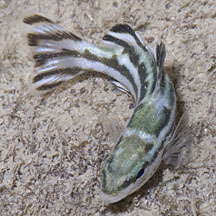 |
|
| fishes text index | photo index |
| Phylum Chordata > Subphylum Vertebrata > fishes |
| Perch Family Terapontidae (Therapontidae) updated Oct 2016 Where seen? These small silvery fishes are sometimes encountered trapped in pools at low tide on both our Northern and Southern Shores. What are perch? Perch belong to the Family Terapontidae. The family name is sometimes also spelt Theraponidae or Therapontidae. According to FishBase: the family has 16 genera and 45 species. They are found in the Indo-West Pacific in marine and freshwater. Features: 3-10cm. Among the features of this family are two spines on their gill covers (operculum), the lower spine usually longer. Most are silvery with patterns of longitudinal lines or spots. They can produce loud noises using their swim bladders. Thus they are sometimes also called grunters or trumpeters. They are also called tigerperches. Adults usually school, while small juveniles are found among floating weeds. What do they eat? These fishes eat other fishes as well as insects, seaweed and other animals that live in the sand. Young perch often shelter in seagrass beds and mangroves. Human uses: Some species of perch are eaten and sold fresh or dried and salted. Some larger species of perch are also highly valued in sport fishing. |
| Family
Terapontidae recorded for Singapore from Wee Y.C. and Peter K. L. Ng. 1994. A First Look at Biodiversity in Singapore.
|
Links
References
|
|
|


